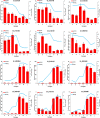Comparative transcriptome analysis of inbred lines and contrasting hybrids reveals overdominance mediate early biomass vigor in hybrid cotton
- PMID: 32041531
- PMCID: PMC7011360
- DOI: 10.1186/s12864-020-6561-9
Comparative transcriptome analysis of inbred lines and contrasting hybrids reveals overdominance mediate early biomass vigor in hybrid cotton
Abstract
Background: Heterosis breeding is the most useful method for yield increase around the globe. Heterosis is an intriguing process to develop superior offspring to either parent in the desired character. The biomass vigor produced during seedling emergence stage has a direct influence on yield heterosis in plants. Unfortunately, the genetic basis of early biomass vigor in cotton is poorly understood.
Results: Three stable performing F1 hybrids varying in yield heterosis named as high, medium and low hybrids with their inbred parents were used in this study. Phenotypically, these hybrids established noticeable biomass heterosis during the early stage of seedling growth in the field. Transcriptome analysis of root and leaf revealed that hybrids showed many differentially expressed genes (DEGs) relative to their parents, while the comparison of inbred parents showed limited number of DEGs indicating similarity in their genetic constitution. Further analysis indicated expression patterns of most DEGs were overdominant in both tissues of hybrids. According to GO results, functions of overdominance genes in leaf were enriched for chloroplast, membrane, and protein binding, whereas functions of overdominance genes in root were enriched for plasma membrane, extracellular region, and responses to stress. We found several genes of circadian rhythm pathway related to LATE ELONGATED HYPOCOTYL (LHY) showed downregulated overdominant expressions in both tissues of hybrids. In addition to circadian rhythm, several leaf genes related to Aux/IAA regulation, and many root genes involved in peroxidase activity also showed overdominant expressions in hybrids. Twelve genes involved in circadian rhythm plant were selected to perform qRT-PCR analysis to confirm the accuracy of RNA-seq results.
Conclusions: Through genome-wide comparative transcriptome analysis, we strongly predict that overdominance at gene expression level plays a pivotal role in early biomass vigor of hybrids. The combinational contribution of circadian rhythm and other metabolic process may control vigorous growth in hybrids. Our result provides an important foundation for dissecting molecular mechanisms of biomass vigor in hybrid cotton.
Keywords: Biomass vigor; Circadian rhythm; DEGs; Heterosis; Hybrid cotton; Overdominant; Transcriptome.
Conflict of interest statement
The authors declare that they have no competing interests.
Figures






Similar articles
-
Comparative transcriptome analysis between inbred and hybrids reveals molecular insights into yield heterosis of upland cotton.BMC Plant Biol. 2020 May 27;20(1):239. doi: 10.1186/s12870-020-02442-z. BMC Plant Biol. 2020. PMID: 32460693 Free PMC article.
-
Expression Patterns Divergence of Reciprocal F1 Hybrids Between Gossypium hirsutum and Gossypium barbadense Reveals Overdominance Mediating Interspecific Biomass Heterosis.Front Plant Sci. 2022 Jul 1;13:892805. doi: 10.3389/fpls.2022.892805. eCollection 2022. Front Plant Sci. 2022. PMID: 35845678 Free PMC article.
-
Overdominance at the Gene Expression Level Plays a Critical Role in the Hybrid Root Growth of Brassica napus.Int J Mol Sci. 2021 Aug 26;22(17):9246. doi: 10.3390/ijms22179246. Int J Mol Sci. 2021. PMID: 34502153 Free PMC article.
-
Comparative transcriptome analysis provides molecular insights into heterosis of waterlogging tolerance in Chrysanthemum indicum.BMC Plant Biol. 2024 Apr 10;24(1):259. doi: 10.1186/s12870-024-04954-4. BMC Plant Biol. 2024. PMID: 38594635 Free PMC article. Review.
-
Molecular concepts to explain heterosis in crops.Trends Plant Sci. 2025 Jan;30(1):95-104. doi: 10.1016/j.tplants.2024.07.018. Epub 2024 Aug 26. Trends Plant Sci. 2025. PMID: 39191625 Review.
Cited by
-
The overexpression of the switchgrass (Panicum virgatum L.) genes PvTOC1-N or PvLHY-K affects circadian rhythm and hormone metabolism in transgenic Arabidopsis seedlings.Biotechnol Biofuels Bioprod. 2024 Oct 3;17(1):126. doi: 10.1186/s13068-024-02574-6. Biotechnol Biofuels Bioprod. 2024. PMID: 39363306 Free PMC article.
-
Non-additive expression genes play a critical role in leaf vein ratio heterosis in Nicotiana tabacum L.BMC Genomics. 2024 Oct 3;25(1):924. doi: 10.1186/s12864-024-10821-1. BMC Genomics. 2024. PMID: 39363277 Free PMC article.
-
Transcriptome Analysis Reveals a Major Gene Expression Pattern and Important Metabolic Pathways in the Control of Heterosis in Chinese Cabbage.Plants (Basel). 2023 Mar 6;12(5):1195. doi: 10.3390/plants12051195. Plants (Basel). 2023. PMID: 36904055 Free PMC article.
-
Comparative transcriptomic analysis reveals the molecular mechanism underlying seedling biomass heterosis in Brassica napus.BMC Plant Biol. 2022 Jun 9;22(1):283. doi: 10.1186/s12870-022-03671-0. BMC Plant Biol. 2022. PMID: 35676627 Free PMC article.
-
Transcriptome Analysis Revealed the Paternal Importance to Vegetative Growth Heterosis in Populus.Plants (Basel). 2024 Aug 15;13(16):2278. doi: 10.3390/plants13162278. Plants (Basel). 2024. PMID: 39204714 Free PMC article.
References
-
- Seelanan T, Schnabel A, Wendel JF. Congruence and consensus in the cotton tribe (Malvaceae) Syst Bot. 1997;1:259–290. doi: 10.2307/2419457. - DOI
-
- Zhang J, Wu M, Yu J, Li X, Pei W. Breeding potential of introgression lines developed from interspecific crossing between upland cotton (Gossypium hirsutum) and Gossypium barbadense: heterosis, combining ability and genetic effects. PLoS One. 2016;11(1):e0143646. doi: 10.1371/journal.pone.0143646. - DOI - PMC - PubMed
-
- Zhang B, Zhang X, Liu G, Guo L, Qi T, Zhang M, Li X, Wang H, Tang H, Qiao X. A combined small RNA and transcriptome sequencing analysis reveal regulatory roles of miRNAs during anther development of upland cotton carrying cytoplasmic male sterile Gossypium harknessii (D2) cytoplasm. BMC Plant Biol. 2018;18(1):242. doi: 10.1186/s12870-018-1446-7. - DOI - PMC - PubMed
MeSH terms
Grants and funding
LinkOut - more resources
Full Text Sources
Molecular Biology Databases

